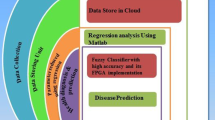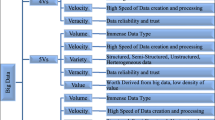Abstract
This paper discusses the design and implementation of an Internet of Things (IoT)-based telemedicine health monitoring system (THMS) with an early warning scoring (EWS) function that reads, assesses, and logs physiological parameters of a patient such as body temperature, oxygen saturation level, systemic arterial pressure, breathing patterns, pulse (heart) rate, supplemental oxygen dependency, consciousness, and pain level using Particle Photon microcontrollers interfaced with biosensors and switches. The Mandami fuzzy inference-based medical decision support system (FI-MDSS) was also developed using MATLAB to assist medical professionals in evaluating a patient’s health risk and deciding on the appropriate clinical intervention. The patient’s physiological measurements, EWS, and health risk category are stored on the Particle cloud and Thing Speak cloud platforms and can be accessed remotely and in real-time via the Internet. Furthermore, a RESTful application programming interface (API) was developed using GO language and PostgreSQL database to enhance data presentation and accessibility. Based on the paired samples t-tests obtained from 6 sessions with 10 trials for each vital sign per session, there were no significant differences between the clinical data obtained from the designed prototype and the commercially sold medical equipment. The mean differences between the compared samples for each physiological data were not more than 0.40, the standard deviations were less than 2.3, and the p-values were greater than 0.05. With a 96.67% accuracy, the FI-MDSS predicted health risk levels that were comparable to conventional EWS techniques such as the Modified National Early Warning Score (m-NEWS) and NEWS2, which are used in the clinical decision-making process for managing patients with COVID-19 and other infectious illnesses.
Access this chapter
Tax calculation will be finalised at checkout
Purchases are for personal use only
Similar content being viewed by others
References
M.M. Abbasi, S. Kashiyarndi, Clinical Decision Support Systems: A Discussion on Different Methodologies Used in Health Care (Marlaedalen University, Sweden, 2006)
M. Abo-Zahhad, S.M. Ahmed, O. Elnahas, A wireless emergency telemedicine system for patients monitoring and diagnosis. Int. J. Telemed. Appl. (2014)
M.K. Ahamad, A.K. Bharti, Prevention from COVID-19 in India: fuzzy logic approach, in 2021 International Conference on Advance Computing and Innovative Technologies in Engineering (ICACITE) (IEEE, 2021), pp. 421–426
S.T. Al Awaidy, A.A. Al Maqbali, I. Omer, S. Al Mukhaini, M.A. Al Risi, M.S. Al Maqbali, A. Al Reesi, M. Al Busaidi, F.H. Al Hashmi, T.K. Al Maqbali, V. Vaidya, The first clusters of Middle East respiratory syndrome coronavirus in Oman: time to act. J. Infect. Public Health 13(5), 679–686 (2020)
J.A. Al-Dmour, A. Sagahyroon, A.R. Al-Ali, S. Abusnana, A fuzzy logic–based warning system for patients classification. Health Inform. J. 25(3), 1004–1024 (2019)
T. Al Ghafri, F. Al Ajmi, L. Al Balushi, P.M. Kurup, A. Al Ghamari, Z. Al Balushi, F. Al Fahdi, H. Al Lawati, S. Al Hashmi, A. Al Manji, A. Al Sharji, Responses to the pandemic COVID-19 in primary health care in Oman: Muscat experience. Oman Med. J. 36(1), e216 (2021)
U. Arun, S. Natarajan, R.R. Rajanna, A novel IoT cloud-based real-time cardiac monitoring approach using NI myRIO-1900 for telemedicine applications, in 2018 3rd International Conference on Circuits, Control, Communication and Computing (I4C) (IEEE, 2018), pp. 1–4
A. Athira, T.D. Devika, K.R. Varsha, Design and development of IoT based multi-parameter patient monitoring system, in 2020 6th International Conference on Advanced Computing and Communication Systems (ICACCS) (IEEE, 2020), pp. 862–866
A. Belle, M.A. Kon, K. Najarian, Biomedical informatics for computer-aided decision support systems: a survey. Sci. World J. (2013)
A. Benhamida, M. Takács, M. Kozlovszky, H. Redjimi, M. Ogbolu, Fuzzy model for early warning score system, in 2019 IEEE International Work Conference on Bioinspired Intelligence (IWOBI) (IEEE, 2019), pp. 000167–000172
M.K. Choudhury, N. Baruah, A fuzzy logic-based expert system for determination of health risk level of patient. Int. J. Res. Eng. Technol. 4(5), 261–267 (2015)
F. Fatehi, R. Wootton, Telemedicine, telehealth or e-health? A bibliometric analysis of the trends in the use of these terms. J. Telemed. Telecare 18(8), 460–464 (2012)
A. Gutte, R. Vadali, IoT based health monitoring system using Raspberry Pi, in 2018 Fourth International Conference on Computing Communication Control and Automation (ICCUBEA) (IEEE, 2018), pp. 1–5
K. Hameed, I.S. Bajwa, S. Ramzan, W. Anwar, A. Khan, An intelligent IoT based healthcare system using fuzzy neural networks. Sci. Program. (2020)
D.S. Kumar, G. Sathyadevi, S. Sivanesh, Decision support system for medical diagnosis using data mining. Int. J. Comput. Sci. Issues (IJCSI) 8(3), 147 (2011)
S. Mahajan, A.M. Birajdar, IoT based smart health monitoring system for chronic diseases, in 2019 IEEE Pune Section International Conference (PuneCon) (IEEE, 2019), pp. 1–5
A. Montesines-Nagayo, N. Bugtai, Design and implementation of a telemedicine information system (TMIS) for managing obstetrical, gynecological and general medical data, in 1st AUN/SEED-NET Regional Conference in Manufacturing Engineering (2008)
A.M. Nagayo, M.Z.K. Al Ajmi, N.V.R. Guduri, F.S.H. AlBuradai, A.R.A. Al Kindi, A.H.A. Al Farsi, An unmanned aerial robot and physiological data monitoring system integrated into a patient transport vehicle for emergency medical services and telehealth, in 2021 5th International Conference on Information Systems and Computer Networks (ISCON) (IEEE, 2021), pp. 1–8
R. Payal, A.P. Singh, A study of various hardware and cloud based Internet of Things platforms (No. 4335). EasyChair (2020)
M. Shatnawi, A. Shatnawi, Z. AlShara, G. Husari, Symptoms-based fuzzy-logic approach for COVID-19 diagnosis. Int. J. Adv. Comput. Sci. Appl. 12(4) (2021)
F. Tagliabue, D. Schena, L. Galassi, M. Magni, G. Guerrazzi, A. Acerbis, C. Rinallo, D. Longhi, A. Ronzani, P. Mariani, Modified national early warning score as early predictor of outcome in COVID-19 pandemic. SN Compr. Clin. Med. 3(9), 1863–1869 (2021)
K. Viswavardhan Reddy, N. Kumar, A framework for remote health monitoring, in ICT Systems and Sustainability (Springer, Singapore, 2021), pp. 101–112
World Health Organization, Middle East respiratory syndrome coronavirus (MERS-CoV): summary of current situation, literature update and risk assessment (2015). https://apps.who.int/iris/handle/10665/179184. Accessed 30 Sept 2021
World Health Organization, Home care for patients with COVID-19 presenting with mild symptoms and management of their contacts: interim guidance, 17 Mar 2020. World Health Organization (2020). https://apps.who.int/iris/handle/10665/331473. Accessed 30 Sept 2021
World Health Organization, COVID-19 weekly epidemiological update, edition 82 (2022). https://www.who.int/docs/default-source/coronaviruse/situation-reports/20220308_weekly_epi_update_82.pdf. Accessed 20 Mar 2022
N. Yellavula, Hands-On RESTful Web Services with Go: Develop Elegant RESTful APIs with Golang for Microservices and the Cloud (Packt Publishing Ltd., 2020)
H. Zhang, J. Li, K. Motegi, Y. Shiraishi, IoT framework of wearable device for telemedicine application, in 2020 59th Annual Conference of the Society of Instrument and Control Engineers of Japan (SICE) (IEEE, 2020), pp. 1616–1621
Acknowledgements
Special thanks to the University of Technology and Applied Sciences-Al Musanna for their unwavering support of this research endeavor, as well as The Research Council (TRC) of Oman for providing the financial resources that made it possible.
Author information
Authors and Affiliations
Corresponding author
Editor information
Editors and Affiliations
Rights and permissions
Copyright information
© 2023 The Author(s), under exclusive license to Springer Nature Singapore Pte Ltd.
About this paper
Cite this paper
Nagayo, A.M., Al Ajmi, M.Z.K., Guduri, N.R.K., AlBuradai, F.S.H. (2023). IoT-Based Telemedicine Health Monitoring System with a Fuzzy Inference-Based Medical Decision Support Module for Clinical Risk Evaluation. In: Reddy, A.B., Nagini, S., Balas, V.E., Raju, K.S. (eds) Proceedings of Third International Conference on Advances in Computer Engineering and Communication Systems. Lecture Notes in Networks and Systems, vol 612. Springer, Singapore. https://doi.org/10.1007/978-981-19-9228-5_28
Download citation
DOI: https://doi.org/10.1007/978-981-19-9228-5_28
Published:
Publisher Name: Springer, Singapore
Print ISBN: 978-981-19-9227-8
Online ISBN: 978-981-19-9228-5
eBook Packages: Intelligent Technologies and RoboticsIntelligent Technologies and Robotics (R0)




